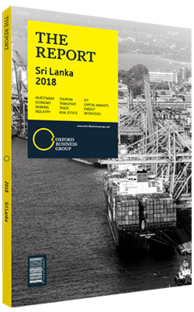Tax reforms and Inland Revenue Act bolster the federal budget in Sri Lanka
Low government revenue is a key challenge facing sustainable macroeconomic growth in Sri Lanka, adversely affecting its finances and limiting the government’s ability to fund infrastructure and social initiatives. Tax reforms launched under an IMF loan agreement, coupled with the Inland Revenue Act (IRA) to improve tax collection, should offer much-needed fiscal space.
Revenue Volatility
Data from the Central Bank of Sri Lanka shows that government revenue as a percentage of GDP has varied, falling from 12%, in 2012 to 11.5% in 2014, before rising to 13.3% in 2015 and 14.2% in 2016. Nominal revenue increased by 15.9% in 2016 to LKR1.69trn ($11bn). Although tax collection has improved in recent years, rising from a low of 10.1% of GDP in 2014 to 12.4% in 2016, this is much lower than many peer countries. Part of the problem is the narrow tax base: in November 2017 the World Bank reported that less than 7% of the labour force and businesses paid income tax. Reductions in taxation without expansions of the tax base, inefficient administration and exemptions are obstacles to this. Non-discretionary spending on salary bills, transfers and interest payments, as well as low government revenue, have limited development, health, education, and social expenditure.
Risks & Rewards
In December 2017 ratings agency Moody’s reported that tax reforms would help return Sri Lanka’s sovereign credit rating outlook, which was “B1” with a negative outlook, to stable. Effective tax collection and steady external financing are set to support an upgrade, and ratings agency Fitch upgraded its rating to “B+” with a stable outlook in 2017.
If foreign exchange reserves remain low, this could weigh on the rating – the IMF reported that gross international reserves were $6bn at the end of 2016 but improved to $7.3bn in the first half of 2017. Moody’s adjusted the outlook from stable to negative in mid-2016 due to rising government debt levels, which will increase by a minimum of $5bn in 2018, and could intensify external vulnerabilities and refinancing risks.
Reform Agenda
In March 2016 the government entered into a three-year, $1.5bn extended fund facility with the IMF, under the condition that it roll out reforms to boost revenue generation and fiscal consolidation. The programme stipulates that the government boost its tax-to-GDP ratio by one percentage point between 2017 and 2019. Stakeholders are launching a sweeping reform programme to streamline and simplify the tax system, broaden the tax base, and rationalise tax exemptions and concessions. Reforms include automation initiatives, such as a revenue administration management information system at the Inland Revenue Department and an integrated Treasury management information system at the Ministry of Finance (MoF).
IRA
One of the most significant tax reforms occurred in September 2017, when Parliament passed the IRA, which takes effect in April 2018 and is expected to boost annual government revenue by a minimum of LKR45bn ($293.8m). The IRA will simplify income sources, reduce exemptions and reintroduce a capital gains tax. It will also modernise cross-border transaction rules to address tax base erosion and tax avoidance. The act also introduces a three-tier corporate income tax structure comprising a low rate of 14%, a standard rate of 28% and a higher rate of 40%.
While this has faced some criticism from the private sector, many stakeholders have welcomed the news. In January 2018 the IMF reported that the IRA is set to boost government revenue by 0.5% of GDP in 2018. MoF figures indicate public revenue rose during the first 11 months of 2017 to hit LKR1.66trn ($10.8bn), putting the primary balance into surplus for the first time in 63 years. Meanwhile, tax revenue hit LKR1.53trn ($10bn), largely due to a value-added tax hike in 2016 (see overview). In November 2017 the MoF reported that it is also working to reform inland revenue tax, and Customs and excise duties to boost revenue to 20% of GDP over the medium term, which should help reduce the budget deficit to a targeted 3.5% of GDP by 2020.
You have reached the limit of premium articles you can view for free.
Choose from the options below to purchase print or digital editions of our Reports. You can also purchase a website subscription giving you unlimited access to all of our Reports online for 12 months.
If you have already purchased this Report or have a website subscription, please login to continue.

